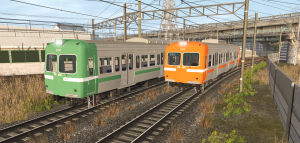
2-car 8000 Series on the left, single-car 7000 Series on the right.
DOWNLOAD
All the necessary dependencies are either included in this package or are avaible on the DLS. Scripts belong to their respective owners.
(Consists are included! Don’t bother with placing individual cars!)
By the early-1990s, Gakunan Electric Railway was looking for a suitable replacement for it’s ageing 5000 Series, wich were ex-Tokyu 5000 Series “Green frog” trains built in the mid-1950s and purchased by Gakunan Electric Railway in the early-1980s when the voltage of the line was switched from 600v to 1500v DC. Furthemore, the struggling railway was looking to introduce one-man operated trains on it’s short line, as a way to save money.
The choice fell, like many other third-sector railways at the time, on 3000 Series trains from Keio Railway’s Inokashira Line, a considerable batch of wich had just been made surplus by the introduction of the brand-new 1000 Series.
Gakunan Electric Railway purchased three intermediate cars and had them rebuilt by Keio Heavy Equipment Co. into cute little single-unit electric railcars by cutting both ends of the cars and replacing them with front cab portions taken from to-be scrapped cab cars. Other modifications included the refurbishment of the electrical equipment and the replacement of obsolete components with ones taken from to-be scrapped 6000 Series trains (among wich, the cab equipment and “T-Shaped” master controller) and of course, the addition of the necessary equipment for one-man operations (in-car farebox and fare displays and so on).
Repainted in Gakunan Electric Railway’s strong orange colour and reclassified into the 7000 Series, the first “new” railcar, MoHa 7001 was delivered to the railway in December 1996, and was followed by the other two (MoHa 7002 and MoHa 7003) in September 1997. After some test runs, MoHa 7001 entered regular revenue services on the 8th of March 1997, with the other two entering service in December of that year, replacing the 5000 Series on regular services.
However, one 5000 Series set was retained as “spare”, to operate occasional high-demand services or as a temporary replacement train if a 7000 Series was unavailable. This continued until 2002, when Gakunan Electric Railway decided to finally fully replace it’s old ex-Tokyu stock by purchasing two more ex-Keio 3000 Series cars. These two, as they were intended to fullfill the same duties as the 5000 Series, were not converted into single-unit railcars like the 7000 Series and instead were reformed into a 2-car set. Refurbished by Keio Heavy Equipment Co. to the same standards as the 7000 Series (including ex-Keio 6000 Series cab furniture and one-man equipment), they were also repainted in the same color scheme as the other trains, altough this time with a different colour: green in place of orange.
Delivered to the railway in mid-2002, the 2-car set, classified as the “8000 Series” began services on the Gakunan Electric Railway on the 16th of November, with the remaining 5000 Series set being retired from services, altough retained on Gakunan Electric Railway’s books up until 2006, when it was officially written-off.
Since then, the life of these trains has been relatively uneventful. One of the only notable events being in 2018, with the withdrawal from service of MoHa 7002 due to it’s high mileage, and it’s prompt replacement by a 2-car 9000 Series set (a third-hand train – an ex-Fujikyuko 1000 Series, itself an ex-Keio 5000 Series). The withdrawn railcar was preserved and it’s now on display at Gakunan Fujioka Station along with Gakunan Electric Railway’s withdrawn electric locomotives.
Currently, owning to the difficult financial situation of the company, no replacement is planned for either series, meaning that these small trains will continue to shuttle up and down the Gakunan line for years to come.
Trivia #1
The 8000 Series set was nicknamed “Gakuchan Kaguya-Fuji” after three different things: the nickname of the company itself (“Gaku-chan”), “Kaugya” (one of the characters of the “Taketoya” heinan-period fable) and “Fuji”, after Fuji city, where the Gakunan Electric Railway is located.
Trivia #2
When the 8000 Series set is not in use, such as during the day, it sits on display at Gakunan-Eno station, the northern terminus of the line.
Trivia #3
As part of the various efforts to keep the company afloat during the pandemic ridership crunch, MoHa 7001 was used for “driving experiences” within Yoshiwara station.